WITNESS TO HISTORY
By Sherry Thomas
HOTEL PHOTOGRAPHY COURTESY OF ADLON KEMPINSKI HOTEL
View of the Bode Museum on Museum Island with the TV Tower in the distance. Photography by georgeclerk
By Sherry Thomas
HOTEL PHOTOGRAPHY COURTESY OF ADLON KEMPINSKI HOTEL
View of the Bode Museum on Museum Island with the TV Tower in the distance. Photography by georgeclerk
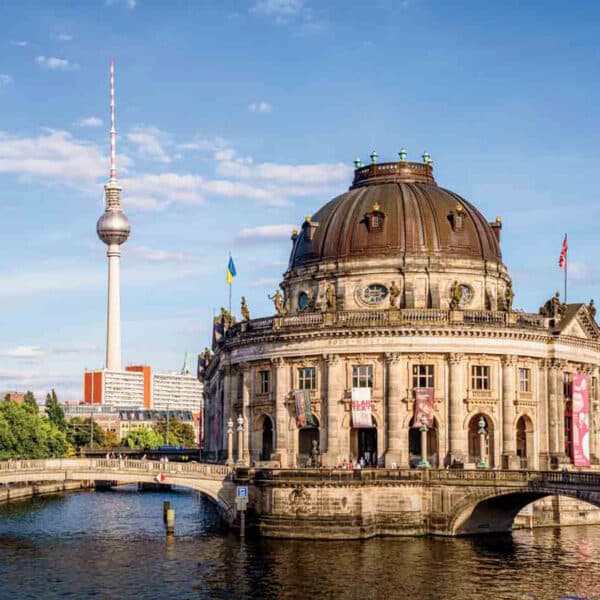
To visit Berlin is to get lost in its stories—tales of tragedy and triumph, resistance and resilience that span nearly eight centuries. Thirty-five years ago this month, one of its most compelling stories took place for all the world to see.
On November 9, 1989, the wall that had divided East Berlin from West Berlin for more than two decades finally came down. Families torn apart during the Cold War were reunited. Economic prosperity flowed from the West to the East. And Berlin was reborn to become one of Europe’s most decadently chic, cosmopolitan cities.
Our Berlin sojourn begins at a site that, like the city, figuratively rose from the rubble of the fallen Wall—the legendary Hotel Adlon Kempinski Berlin. Situated just steps from the iconic Brandenburg Gate, merely staying at the hotel is an immersion in 20th-century German history.
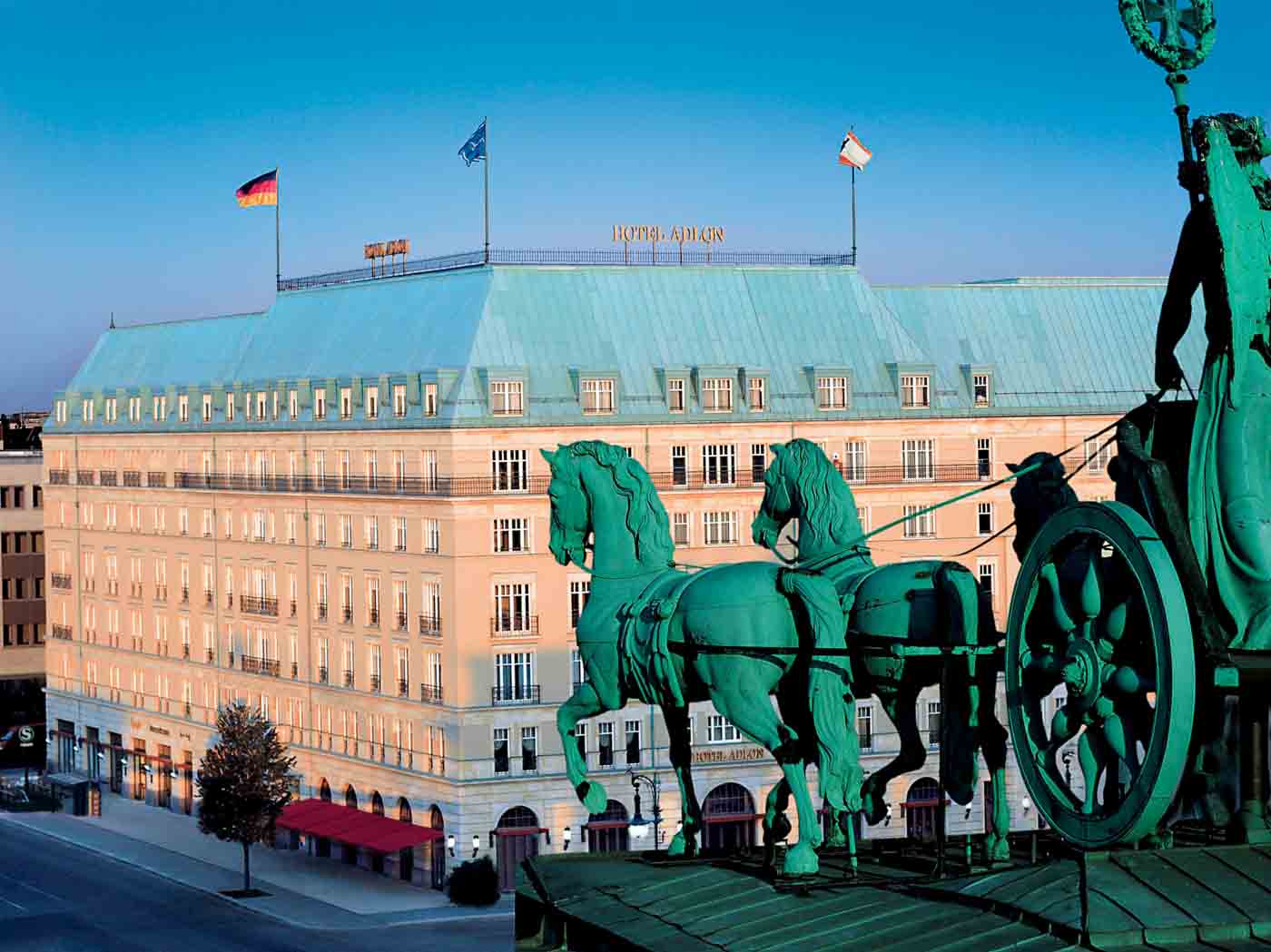
Lorenz Adlon opened the original Adlon Hotel in 1907 with much fanfare. Kaiser Wilhelm II, the last German Emperor and King of Prussia, attended the opening festivities and was one of the hotel’s biggest supporters as he sought to create an opulent gathering space for elite Berliners and visiting nobility.
A glamorous new era for Berlin had begun with the Adlon guest list reading like a “who’s who” of the German Empire and the Weimar Republic. Balls were hosted here. Kings and queens drank from the famous wine cellar. Hollywood celebrities, including Greta Garbo, Marlene Dietrich, and Charlie Chaplin, passed through its doors.
Lorenz Adlon died in 1921, leaving his fortune to his daughter and son, Louis Adlon. Louis and his wife, Hedda, (who established the hotel’s afternoon English tea tradition) ran the hotel during World War II setting up part of the hotel as a military hospital. News outlets from around the world, including the Chicago Tribune, established offices in the Adlon to cover the war. The area around Brandenburg Gate was designated as a neutral zone, hence the hotel’s nickname of “Little Switzerland.”

In 1945, after his release from a Russian interrogation, Louis Adlon died. That same year the hotel’s wine cellar caught fire, destroying all but one wing of the hotel. Devasted by the losses, Hedda Adlon took up residence at a hotel in Berlin owned by another prominent hotel family, the Kempinskis.
In 1957, Hedda sold the Adlon name to the Kempinskis. The hoteliers promised her that if the Berlin Wall ever came down and the city was reunited, the Adlon would be rebuilt in its former glory.
It was a day many never dreamed possible. But on August 23, 1997, the Adlon reopened as Hotel Adlon Kempinski. German Federal President Roman Herzog was the guest of honor, making the Adlon perhaps the only hotel in the world to have been opened twice by a head of state.
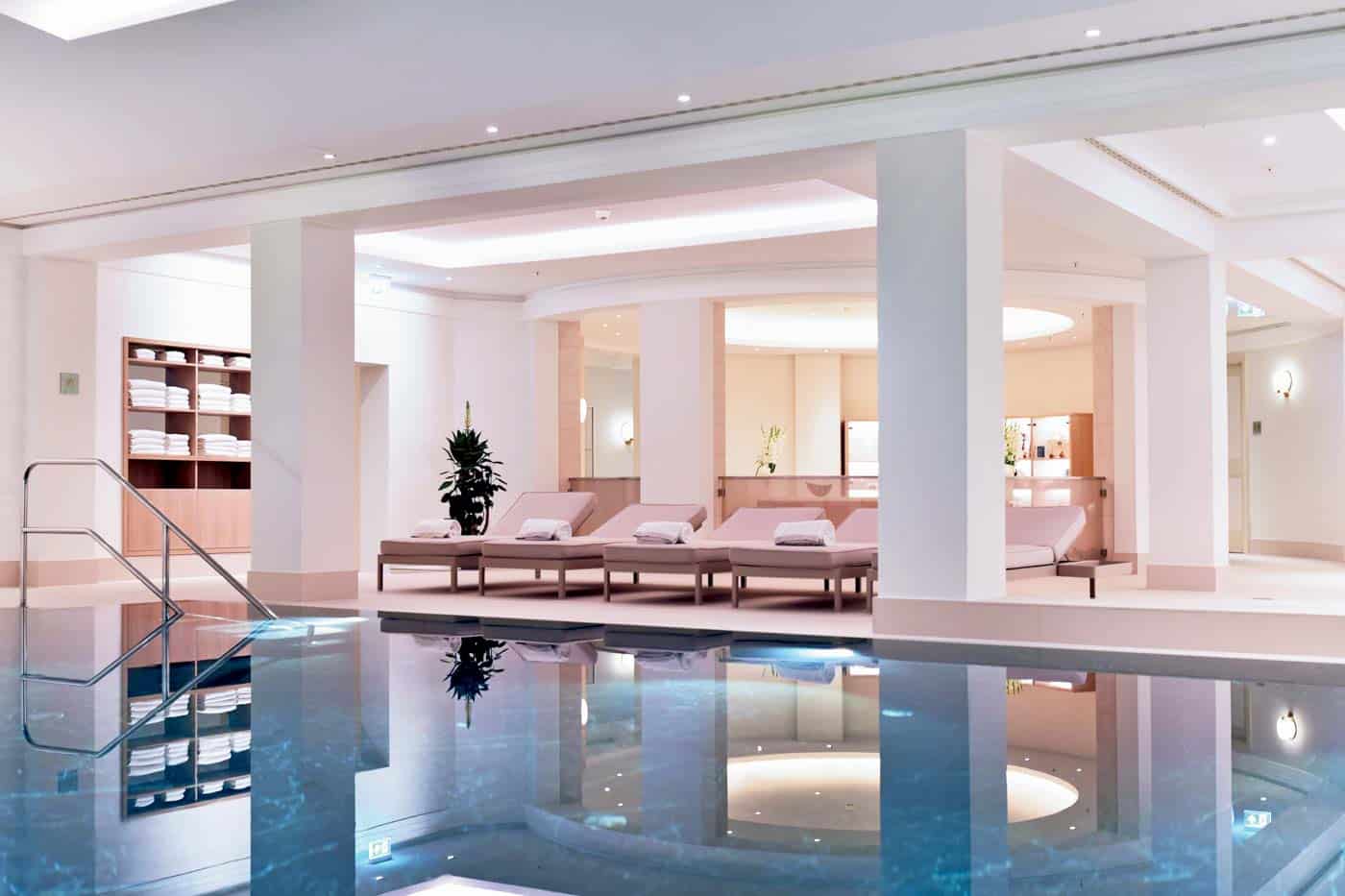
Hotel Adlon Kempinski Berlin is a painstaking replica of the original Aldon, which was demolished in 1984. From the iconic elephant fountain in the lobby that bears stained glass from the original to the vintage detail of the elevators, one would never know that this version of Adlon wasn’t built until the late 1990s.
The “new” Hotel Adlon Kempinski Berlin has 307 luxurious guest rooms and 78 fabulous suites (including several with a private butler). Carrying forward the prestigious Adlon pedigree, it regularly hosts the royals (there is a secret elevator and private entrance), celebrities, and leaders of today’s generation, including several U.S. presidents (President Barack Obama dined with German Chancellor Angela Merkel in the hotel’s two-Michelin starred restaurant, Lorenz Adlon Esszimmer), the late Queen Elizabeth II, and the Prince and Princess of Wales (aka Kate and William).
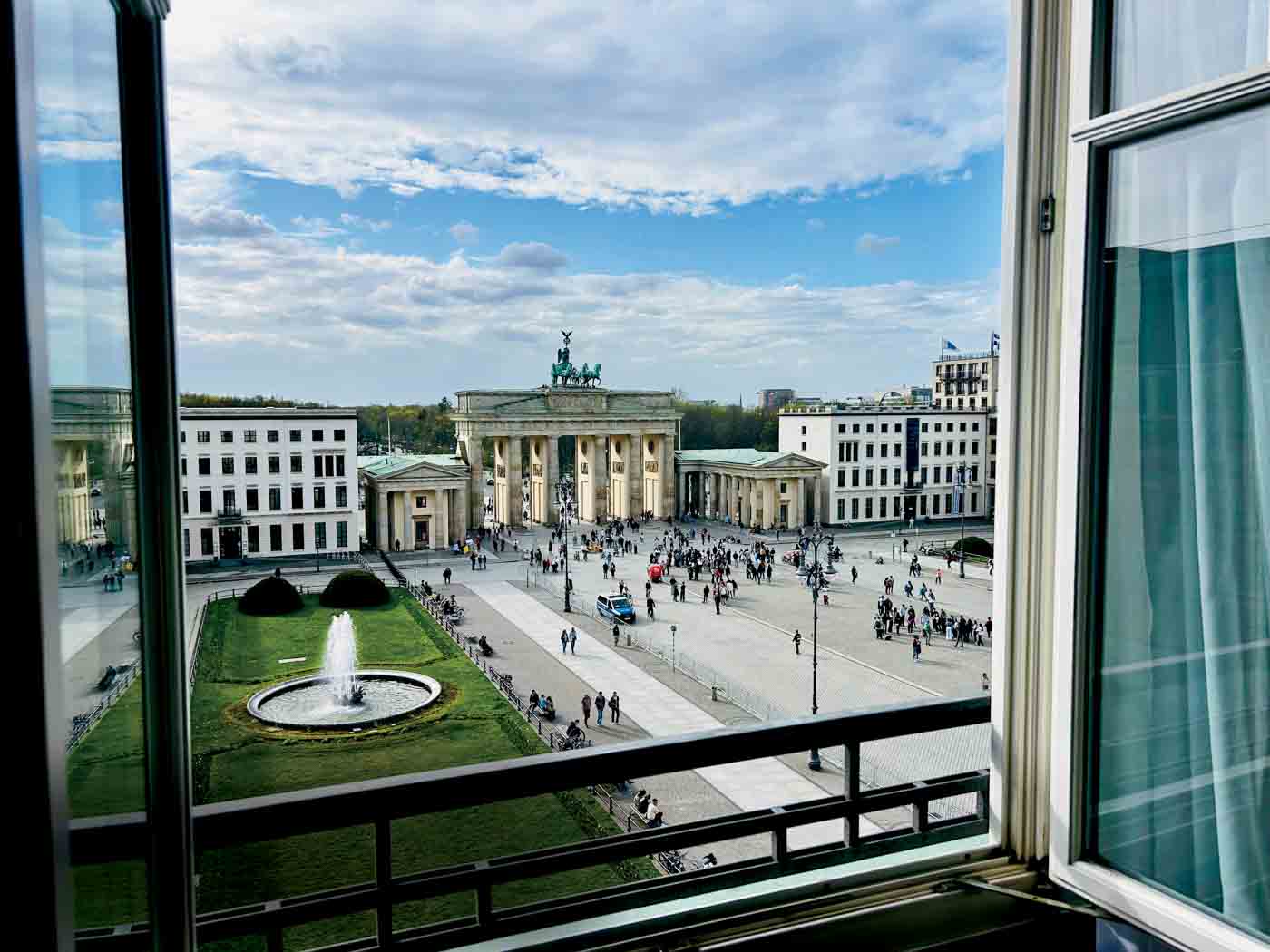
Upon arrival at the hotel, one could be tempted to linger in its grand lobby, a space filled with Italian antiques, Murano glass chandeliers, and the iconic elephant fountain—a link between the hotel’s glorious past and present. But once we got the keys to The Brandenburg Suite, we couldn’t wait to check out the view.
It’s spectacular, of course, and there was a bottle of champagne with fruit and delicious Sawade Berlin chocolates waiting to enjoy as we opened the French windows for our first impressions of the city. The imposing Brandenburg Gate, a late 18th-century landmark, steals the scene as it reigns over a street (Pariser Platz) that is today filled with embassies from around the world.
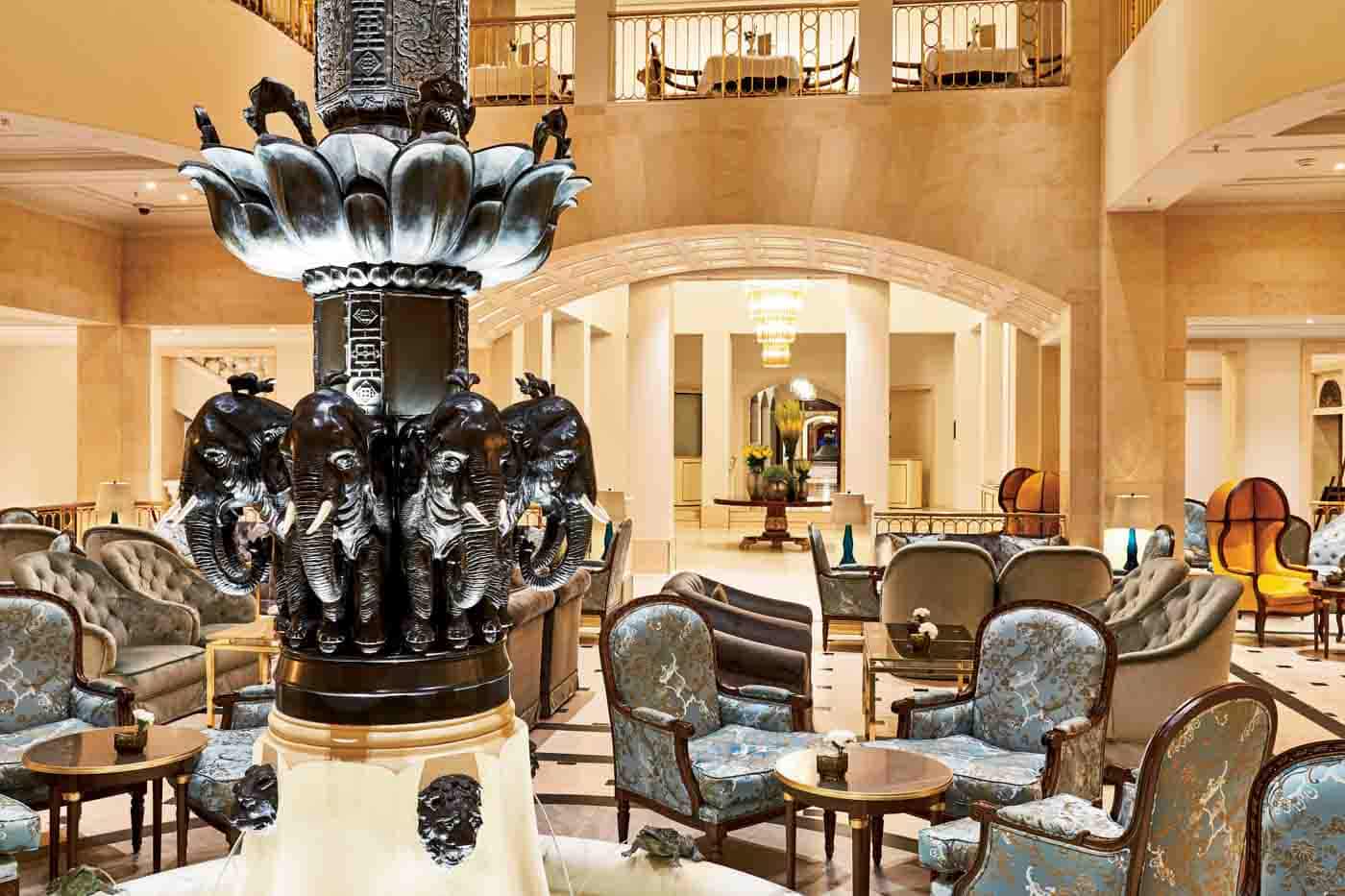
Located in the heart of the Mitte neighborhood, the hotel offers an ideal place to explore the city’s many attractions (see Best of Berlin), and the concierge has a wealth of information about available walking tours. We chose one that included several of the important nearby sites, including the poignant Memorial to the Murdered Jews of Europe, which is aptly described as a “place of contemplation, a place of remembrance and warning.”
After an afternoon of touring, we were excited to return to the hotel and explore it further. Hotel Adlon Kempinski Berlin offers two separate wellness areas to relax and recharge. Treat yourself to a massage or beauty treatment at the Adlon Spa by Resense or check out the newly renovated, nearly 10,000-square foot Adlon Pool. In addition to the heated pool and whirlpool, there is an impressive new sauna menu featuring everything from a Finnish sauna to a steam bath in the style of an Arabian hammam.

There’s also a new pool bar that offers something for every palate from freshly prepared fruit and vegetable juices to Wiener schnitzel with cucumber and potato salad and, of course, the popular Adlon currywurst with edible gold leaf.
Speaking of food, the hotel’s dining offerings are next level. In addition to the daily champagne and caviar breakfast (which also includes a hearty German buffet and made-to-order options), the hotel has two fantastic restaurants. For truly fine dining, opt for the Lorenz Adlon Esszimmer. However, The Brasserie Quarré, which offers international, regionally inspired cuisine, is also excellent. Order the foie à la berlinoise (Berlin veal liver served with a potato waffle, apple ragout, and shallots) for a savory introduction to German cuisine.
Our days in Berlin passed far too quickly and we saw things there that I will never forget. The tragedies and triumphs of the war that tore this city apart are omnipresent. And yet, the reborn Hotel Adlon Kempinski stands as a testament to the reborn Berlin— a tangible celebration of freedom, unity, and enduring hope.
For more information, visit kempinski.com/adlon.
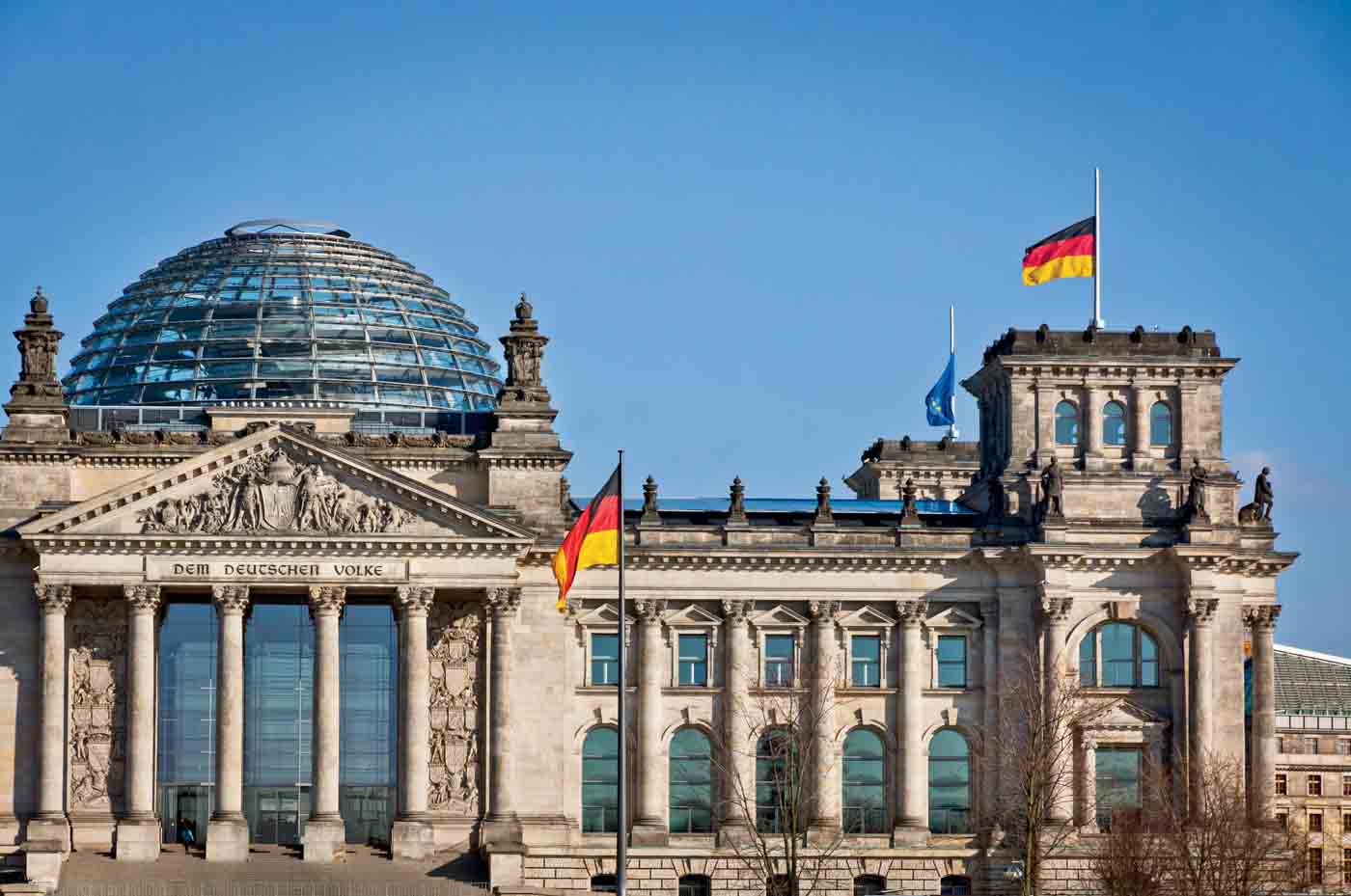
Berlin is a vibrant city, home to spectacular architecture, serene parks, world-famous museums, and sites that changed the course of history. Here are five things you won’t want to miss.
Berlin Wall & Checkpoint Charlie
Several guided walking tours are available to see the remains of the Berlin Wall and Checkpoint Charlie, a border crossing opened by the Allies after the city was divided in 1945. One of Berlin’s most recognizable sites, the checkpoint has been the setting for spy novels and cinematic thrillers like the James Bond movie Octopussy. After you visit (and take a photo at) Checkpoint Charlie, tour The Wall Museum at the East Side Gallery (the longest surviving section of the wall), an exhibition that uses more than 100 screens, projectors, and interactive displays to tell the story of its history, including the famous confrontation between American and Soviet tanks in 1961, and to honor those who were murdered while trying to cross the Wall.
Museum Island
In the heart of Berlin on Spreeinsel (Spree Island), you can visit five world-class museums that comprise a UNESCO World Heritage site. The first of the buildings, the Alte Museum (Old Museum) was built at Lustgarten in 1830 to house historically significant collections and art. In 1855, the Royal Prussian Museum—today known as the Neues Museum (New Museum) and home to the famous 3,000-year-old bust of Nefertiti—was added to the island, followed by the Alte Nationalgalerie (Old National Gallery) in 1876. In 1904, the neo-baroque Kaiser Friedrich Museum (today known as the Bode Museum) was built at the tip of Museum Island. The Pergamon Museum was added in 1930 as the last of the five. Although the Pergamon Museum is temporarily closed for renovation, you can still visit the Pergamon Museum: The Panorama exhibition to see some of its treasures.
Tiergarten Park
Tiergarten Park, Berlin’s version of Manhattan’s Central Park, is literally just steps from the Hotel Adlon Kempinski Berlin. Walk through the Brandenburg Gate to enter the park, which stretches for more than 500 acres, to find a zoo, tree-lined paths for walking or jogging, cafes, several major memorials, including the Victory Column, and an open-air gas lantern museum. The long stretch of green space is the site of former royal hunting grounds, which were converted to a park in the late 17th century by the Duke of Prussia. During World War II the park suffered major damage, and following the war Berliners cut down the park’s trees for fuel. The park was replanted in 1949 thanks to donations from across Germany. Today, it is the heart of the city and the center of Berlin life.
Reichstag Building & Dome
Home to the German parliament and the setting for some of the most turbulent moments in Berlin’s history, the 1894 Reichstag building was called “the pinnacle of bad taste” by Kaiser Wilhelm II. Over the 20th century, it served in many roles and, at one point, fell under Hitler’s control. By the end of World War II, it was in ruins. In 1990, the Reichstag was the site of the official German reunification ceremony and has since been restored and designed. One of the highlights of any visit to the Reichstag is its glass cupola dome—a symbol of Germany’s commitment to renewable energy.
Berlin TV Tower & Observation Deck
Between 1965 and 1969, the Soviet-controlled German Democratic Republic built the Berliner Fernsehturm, a TV tower used to broadcast propaganda to East Berlin and to surveil the city. Today, under ownership of Magnicity (which also operates the 360 CHICAGO Observation Deck at the John Hancock Building) the Berlin TV Tower has been transformed into an observation deck with historical exhibits, a virtual reality experience, a bar, and a revolving restaurant. Featuring the most panoramic views of the city from dramatic heights, a visit to the tower is a must.
Sign Up for the JWC Media Email